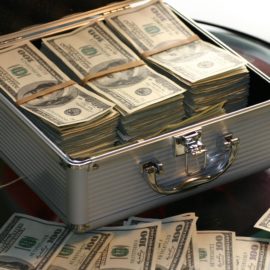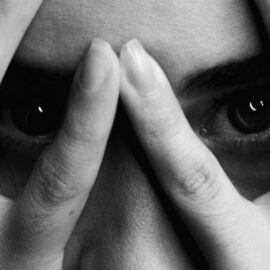
When did Jordan Belfort’s drug use start? What were Belfort’s primary addictions?
Despite Belfort’s belief that money could solve any problem, his riches did nothing but fuel his drug use and enabled him to endanger himself in ways that only the super-wealthy can. In The Wolf of Wall Street, Jordan Belfort recounts his worsening drug addiction and the self-destructive behavior it inspired.
Here’s a look at the damage Jordan Belfort’s drug use caused.
The Downward Spiral
Jordan Belfort’s drug use ranged among many drugs, but his primary addictions were to sex and to methaqualone, commonly known as “Quaalude,” which was prescribed to him after a back injury. He eventually became hooked on the pills and used them for their high instead of pain relief. Belfort was on a particularly strong Quaalude high when he learned that the FBI was after him for money laundering. He rushed home, delirious on drugs, crashed into seven cars, and injured one person. For once, the police arrested Belfort, though as always before, he suffered no consequences—this time thanks to a friend who knew a judge.
(Shortform note: Quaaludes were developed in 1951 as a sedative, not a painkiller as Belfort suggests. The drug was heavily prescribed in the 1970s, but by the early ’80s, its dangerously addictive nature and side effects caused it to be banned in the US. How Belfort could be prescribed Quaaludes for back pain years after their production was outlawed is unclear. Quaaludes’ side effects include depression, memory loss, neurological problems, and respiratory issues. As dangerous as Quaaludes are, the withdrawal symptoms for those who suddenly stop taking them can include seizures, vomiting, weakness, and confusion.)
In 1996, Belfort’s doctors found a way to treat his pain without the use of Quaaludes, but that didn’t stop Belfort from using them. He, his wife, and their friends went to Rome, where he and his friends were so high on drugs that Belfort insisted his yacht be put to sea in the face of an oncoming storm. The storm turned into a massive gale with 50-foot waves, endangering the lives of everyone onboard, though Belfort recalls that he and his friends prioritized saving their drugs over themselves. The Italian navy rescued Belfort and his crew shortly before his yacht sank in the storm, and even though Belfort would not be held accountable, he promised himself and his wife he’d quit the Quaaludes.
(Shortform note: The storm that Belfort sailed his yacht into was caused by a mistral—a powerful northwesterly wind that blows into the Mediterranean from France. While mistral storms are often navigable, the one that sank Belfort’s ship was particularly powerful. Though mistrals have been known to reach hurricane force, ashore in France the mistral brings sunny weather and cool waters along the coast.)
| Accountability and the Rich When wealthy people such as Belfort aren’t held accountable for their actions, such as crashing cars or sinking yachts, it creates more than a simple double standard. While vices and criminal recklessness are brushed off as eccentricities for the rich, the impoverished are stigmatized and denied vital resources for the same behavior. This can become a life-or-death issue, as restrictions on aid programs based on these behaviors can shorten the lives of less wealthy people while the rich go unpunished. Some argue that this double standard has created the public perception that our entire social structure is rigged to benefit the wealthy at everyone else’s expense, potentially endangering the fabric of society. Perhaps the most well-known example of class-based justice inequality is the “affluenza” defense, a legal argument that people who live in the sheltered world of the wealthy aren’t mentally equipped to understand the consequences of their actions—and therefore can’t be held liable for them. However, most arguments addressing justice inequality focus on wealth redistribution, not an overhaul of the criminal justice system. |
Fear and Loathing in Long Island
In a way, Belfort kept his promise. By 1997, he’d reduced his use of Quaaludes by replacing them with cocaine. He writes that his cocaine use, however, led to insomnia, paranoia, and instances of violence at home—such as when he destroyed his furniture with a knife while looking for a missing stash of drugs. He even threatened his wife Nadine, and when she told him that she was leaving, he burned her clothes in retaliation. Afraid that she would return to take their children, he planned to take so many drugs that he wouldn’t have to sleep—he’d always be on alert.
(Shortform note: The escalation in Belfort’s drug abuse isn’t uncommon for the deeply addicted. Drugs engage the brain’s reward cycle, but over time, the body adjusts to the drug’s ongoing effect on the nervous system, requiring larger doses to achieve the same result—or else, switching drugs entirely to recreate a similar high. Because the dopamine and serotonin that form the brain’s reward system are produced by our own bodies, the same cycle of stimulus, adaptation, escalation, and dependency occurs in forms of addiction not related to drugs at all, such as gambling addiction, porn addiction, or even addiction to work and exercise.)
Nadine did indeed come back for their children. A fight ensued in which Belfort says he kicked his wife down a flight of stairs before bundling their daughter into his car and driving it straight through their garage door. Belfort was arrested again, and after his arraignment, his lawyer suggested he lie low in Florida and let things cool down. Just as before, Belfort decided to cope with his situation by staying high on drugs every moment of the day. If he came down for even a moment, he’d have to confront the mess he’d made of his life.
(Shortform note: The interplay between drug abuse and domestic violence is complex—one doesn’t necessarily lead to the other, though in cases such as the one Belfort describes, the two can exacerbate each other. Drug addiction leads to a loss of control, while domestic violence springs from a desire to control others. Drug use brings a loss of inhibitions and an altered mental state that can increase an addict’s urge to control something while removing any moral compunctions they may have against using violence to do so. However, research shows that drug addiction doesn’t cause domestic violence. Many domestic abusers aren’t addicts at all, and those who are remain domestic abusers even when they’re sober.)
Rock Bottom and Recovery
Belfort had hit the lowest point of his life. Since drugs had become his only refuge, he couldn’t see any way out of his situation that didn’t involve drugs as part of the solution. Belfort describes his head-on collision with depression and attempted suicide before giving in to professional help, as well as the peace and self-awareness that came after.
In a fit of anger and depression, Belfort attempted suicide by taking morphine pills, though he argues that it wasn’t a real suicide attempt because he knew a friend of his was near and would be able to save him. After having the morphine pumped out of his system, Belfort was placed on an involuntary psychiatric hold, during which Nadine arranged for an intervention—she let Belfort know that unless he went to rehab, he’d never see her again. Belfort’s interventionist explained that he and Nadine were deeply codependent in that she’d been enabling his rampant drug use while he took advantage of his power in their marriage.
(Shortform note: In Codependent No More, Melody Beattie defines codependency as a prolonged stress reaction in which someone such as Belfort’s wife Nadine becomes so obsessed with another person that they lose sight of themselves and their boundaries. To break out of codependency, you must first detach from your unhealthy dependency on the other person and focus on your own emotional needs. While Nadine arguably took this first step by leaving Belfort and refusing to see him, she was still tending to his needs by pressuring for his admission into rehab.)
Once in rehab, Belfort asserts that his urge to do drugs simply turned itself off, though he felt his sex addiction would remain more of a problem. He slowly opened up to his fellow rehab patients, while admitting to himself that he ought to be dead from the sheer amount of drugs he’d been taking. He returned to New York where he was able to stay sober, though his recovery sponsor pointed out to him that even though he’d stopped using drugs, he was still in danger of repeating the behaviors that he’d used the drugs to justify.
| Involuntary Holds and Rehab Though Belfort went to rehab of his own volition, the involuntary psychiatric hold he started under was, by definition, against his will. Someone can be placed on a psychiatric hold if the police or a mental health provider determines that they pose a danger to themselves or others. The rules on being released from a psychiatric hold vary from state to state. In Florida, where Belfort was hospitalized, an involuntary hold may only last for 72 hours unless extended by a judge. However, during that time, the hospital conducts a psychiatric exam, which is used as a basis for the court to decide whether a person should remain under care. While Belfort describes his experience in rehab as generally positive, if annoying at times, that hasn’t been the case for everyone. In her memoir The Woman in Me, pop star Britney Spears recounts an extremely traumatic rehab experience during which she had no privacy or autonomy, doctors physically examined her daily, and she was medicated without her consent. Though Spears was certainly more famous than Belfort, his financial worth was higher than hers, and he still had control of his fortune whereas Spears did not, which may account for the stark difference in their treatment. |
Nevertheless, Belfort recalls that those first sober months were the clearest, happiest, and healthiest he’d had in over 10 years. He worked on trying to repair his marriage, spend time with his children, and explore his new reality. Many of his old friends drifted away, and his relationships with the ones who stayed changed. Stratton Oakmont had long since closed down, and Belfort’s other financial streams folded. He didn’t care—he was sober, rich, and happy—until September 1998, when the FBI arrested him for money laundering and fraud, shortly after which, Nadine filed for divorce.
(Shortform note: Belfort ends his memoir on a cliffhanger—his arrest by the FBI—without delving into their case against him or the path that led to his eventual conviction. Those details are in his follow-up memoir, Catching the Wolf of Wall Street, published in 2011. In prison, Belfort served time with famed comedian Tommy Chong, who’d been convicted of selling drug paraphernalia. According to Belfort, it was Chong who inspired him to write his memoir, which was bought by Random House before it was finished, with a deal for Martin Scorsese’s film adaptation also in the works. Upon his release in 2006, Belfort once again landed on his feet.)






